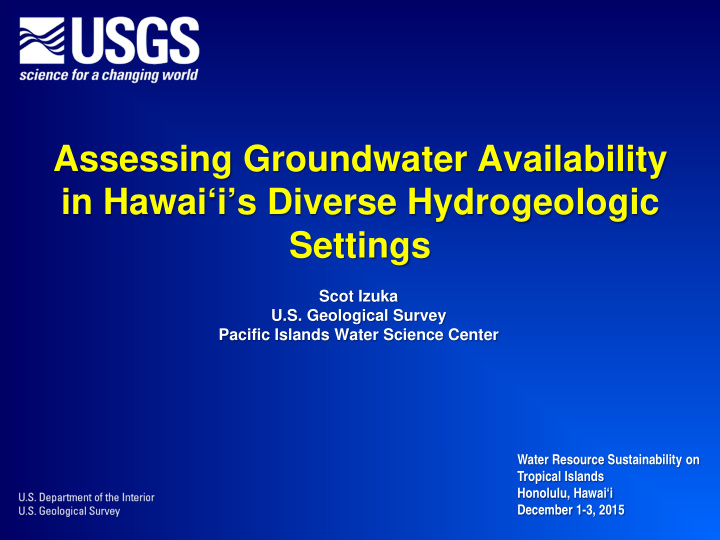



Assessing Groundwater Availability in Hawai‘i’s Diverse Hydrogeologic Settings Scot Izuka U.S. Geological Survey Pacific Islands Water Science Center Water Resource Sustainability on Tropical Islands Honolulu, Hawai‘i December 1-3, 2015
Groundwater Availability — a Definition Availability of fresh groundwater
What Limits Groundwater Availability? Quantity Consequences
In Hawai‘i, Pumping is Less Than Recharge (32%) Water budget, in million gallons per day
Consequences of Pumping Recharge Wells Water-table decline Outflow Inflow Reduced discharge Streams New Storage Volume Outflow Submarine GW discharge Saltwater rise
Consequences and Availability • Any amount of groundwater withdrawal has consequences • Availability of groundwater depends on what consequences are deemed acceptable • Type and magnitude of the consequences depend on - How much water is withdrawn - Hydrogeologic setting
Hawai‘i’s Diverse Hydrogeologic Settings Low-perm. dikes Low-perm. lava flows Perched? Caprock High-perm. lava flows ?
High-Permeability Lava Flows, no Caprock Submarine discharge Water table Ocean Freshwater lens Saltwater
Pumping from Thin Freshwater Lens Water-table decline Reduced discharge Well Saltwater rise & encroachment
Freshwater Lens with Caprock Discharge to Discharge streams/springs to ocean Caprock Water table Freshwater lens Saltwater
Pumping from Freshwater Lens with Caprock Water-table decline Reduced discharge to streams & ocean Well Saltwater rise & encroachment
Freshwater Lens in Low-Permeability Aquifer Discharge to streams Discharge to ocean Thick freshwater lens Saltwater
Pumping from Low-Permeability Aquifer Reduced discharge Reduced to streams discharge to ocean
Dike-Impounded Groundwater Dikes Discharge to ocean Freshwater lens Saltwater
Dike-Impounded Groundwater Discharge to springs & streams Discharge to ocean Saltwater
Withdrawing Dike-Impounded Groundwater Loss of spring discharge Reduced discharge to ocean Reduced discharge Tunnel to streams Well
Approaches to Quantifying Consequences
Wailuku, Maui—Freshwater Lens (Gingerich, 2008, USGS SIR 2008-5236) Acceptable Consequence Salinity 1% that of seawater or better Approach Numerical groundwater model Solute-transport capable
Wailuku, Maui—Freshwater Lens (Gingerich, 2008, USGS SIR 2008-5236) Percentage of yield Pumping rate Number of well meeting acceptable (Mgal/d) fields criterion 20.1 4 23% 27.1 14 89%
Līhu‘e, Kaua‘i —Thick Lens, Low Permeability (Izuka and Oki, 2002, USGS WRI 01-4200) Acceptable Consequence Not specified Reduced discharge to streams Approach Thick freshwater lens Numerical groundwater model Capable of assessing streamflow depletion
Effects of Pumping Additional 1.2 Mgal/d from Līhu‘e Decrease in GW discharge to streams = 1.1 Mgal/d
USGS Groundwater-Availability Assessments
USGS Groundwater Availability Study in Hawai‘i Numerical Models Kaua‘i O‘ahu Maui
Summary • Groundwater availability limited by consequences community is willing to accept • Hawai‘i—diverse hydrogeologic settings, each with its own set of pumping-related consequences • Assessing groundwater availability in Hawai‘i requires: Identifying hydrogeologic setting and associated consequences of groundwater withdrawal Setting acceptable limits for those consequences Using approaches that quantify consequences for the desired pumping
Recommend
More recommend